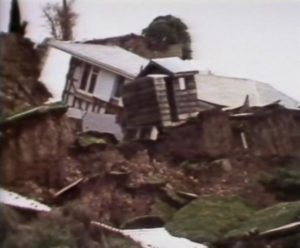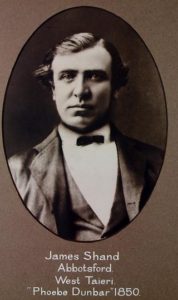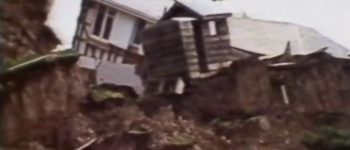1979: Abbotsford
August 9, 2019
By AHNZ
 Today in New Zealand History: New Zealand woke up to the great Abbotsford Landslide (8 August 1979.) 69 Houses literally went down the drain in one big swoop.
Today in New Zealand History: New Zealand woke up to the great Abbotsford Landslide (8 August 1979.) 69 Houses literally went down the drain in one big swoop.
Abbotsford punctuated the public’s dissatisfaction with The State. New Zealanders had submitted to an era of Muldoonist Slave Culture that was now wearing very thin. Big Brother Muldoon once seemed a Juggernaut who would protect the Sheeple so they would not have to look within for strength.
All in the same year, 1979, Kiwis watched their homes fall in a pit and their loved ones crushed into Antarctic ice while their own cars were rationed back to them.
“Prime Minister Rob Muldoon refused to call a state of civil emergency or allow the Earthquake and War Damage Commission to pay full compensation on damaged or destroyed houses.”- Wikipedia
“…there was widespread confusion over what compensation they could receive from the Earthquake and War Damages Commission….After watching their houses slide away from them, Abbotsford residents then had to deal with on-going stress over compensation and finding new homes.”- Ngā Taonga Sound Archives: The Abbotsford Disaster; RNZ
The uselessness of The State to prevent harm or to aid the Abbotsford victims convinced Kiwis it was time once more to look within: They turned to KZ7 Honour Culture. That’s another story.
Abbotsford Station

Aged 16, James Shand lost his father very soon after the family had migrated from Scotland (1850) to Settle in bush at the edge of Dunedin. Not perturbed, Shand and his 6 siblings worked hard in the little locality once named Abbotsford and after 8 years James was able to freehold a fine farm of his own on the west Taieri Plain.
Abbotsford Farm, named after Shand’s first home in New Zealand, eclipsed the old namesake to became great. From wasteland covered in cabbage trees and flax, Shand built a model farm employing many men and horses and new-fanged capital assets. By 1874 the railway conveniently passed right through the farm and here Abbotsford railway station was established. Shand became so wealthy he purchased Edendale Estate in 1882 and his family spread and became useful and productive New Zealanders. Golden! Yet by age 54, Shand had become an alcoholic and a gambler when he literally bet the farm, Abbotsford, and lost it. At this stage Shand had become a bankrupt, in debt to his fellows up to his eyeballs¹. Unable to go on, James undressed and slipped into the Taieri river where he drowned.
Dunedin Eats Abbotsford
As with so many towns and localities the once independent Abbotsford was gobbled up by the sprawling city. Dunedin, once 5 miles distant, now claimed the the old rural settlement as a “residential suburb with virtually no retail or service sector of its own.”² Before it was all made into houses a major business in Abbotsford was a brick and tile works. This hints at ready access to clay. Indeed, earlier observers of Shand’s farm noted the soil’s want of firmness. The soil of Abbotsford is partly composed of sand in “extremely fine particles” it was noted in 1879.³ Sounds a bit slippery doesn’t it?

The State resolved to give Dunedin’s growing metropolis a new motorway and set to building it between 1966-8. This Dunedin Southern Motorway directly caused slippages and several homes needed to be demolished as a result. The land was stabalised using sand excavated from nearby Harrison’s Pit.
This sand quarry, Harrison’s Pit, was at the foot of the slope to which the Abbotsford homes slipped into. The Government was destabilising another housing area to patch up the damage it had already done!⁴ The stage was set.
Not content to wait though, leaky Government water pipes spilled a catalyst all over the vulnerable area to make instant pudding out of Abbotsford. Just add water…
Dunedin City Council (DCC) estimated it was about 5 million litres per year since 1976. This represents an average leakage rate of 6-9 litres per minute, with 4-5 litres per minute likely to infiltrate the ground. The annual infiltration rate of rainfall into the slide is estimated to be about 12-13 litres per minute. The water leaking from the main since 1976 is thus equivalent to a 30-40% increase in rainfall over that period. It is likely, therefore, that the combined effects of greater than average rainfall over the past decade and water from the leaking water main raised groundwater levels in the landslide area and advanced the onset of slope failure.- The Abbotsford Landslide, Hancox (2002); Tephra
Just another brilliant performance. Thanks, The State. Down into Harrison’s Pit it all fell. The State caused the slip in the first place, then strung everyone along for over a year while a report was written. As the earthquake-shaken people of Christchurch have also experienced, Government Insurance is very far from forthcoming when money is required to flow from them rather than to them.
Cabbage trees and flax held Abbotsford together until farmer Shand made it his farm, stabilising it with trees. In the hands of locals with local knowledge the settlement need never have gone down hill. The State paved the Golden Scotchman’s paradise, turning Abbotsford into a concrete toboggan on butter and then watched it slip away like Max Merritt’s girlfriend.
At least, on this occasion, nobody had to die.
“And as for the land that slipped, much of it now sits as parkland, and a reminder of Mother Nature’s power.”- Earthquake Commission; Facebook
State history will have you focus on the victims or “our ancestor’s follies” or “the power of God and Nature” or something. Here at the Anarchist history of New Zealand we have no qualms about holding Statism responsible.
—
1 Meeting of Creditors re J.Shand; Evening Star (1889)
3 Chats with the farmers; Otago Witness (1879); Papers Past
4 Ref. The Abbotsford Landslide, Hancox (2002); Tephra
Ref. Mr and Mrs James Shand; Otago Settlers Museum
Ref. Mrs James Shand; Otago Settlers Museum
Video Ref. Extract from Landmarks (1981) episode 7, ‘Nature Fights Back’
2 thoughts on "1979: Abbotsford"
Leave a Reply
 Like Comment Share
Like Comment Share






I am interested in the history of Abbotsford Farm – is it still owned by the Blair family ?
Thanks for asking. I understand the farm is long gone and the place has become an urbanised part of Dunedin now. Do loop me in if you find it though please.